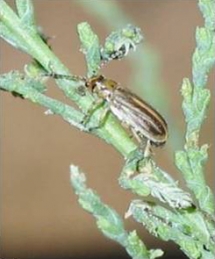The overall, holistic goal must always be kept in mind in order to ensure successful restoration. The Virgin River stretches from Zion National park to Lake Mead, and provides key ecosystem services for wildlife and humans alike. The knowledge and tools for restoration and monitoring that have been acquired from the past seven years of research in the Virgin River will promote native habitat and the ultimate de-listing of the SWFL through habitat restoration.
Beetles were moved by managers to St. George in 2006, then dispersed down the Virgin River where in 2010 they defoliated plants through the Virgin Valley and in subsequent years continued moving to the Mormon Mesa area in 2011 and in 2012 to Lake Mead, including the inflow from the mainstem Colorado River. Beetles scrape the foliage, causing it to dry out, but it takes several years to kill the weed. Instead, they will gradually decline leaving native plants to recover and re-colonize the riverbanks.
Background
2009 – 2014 - surveys were done along the Virgin River to assess biodiversity prior to and after the tamarisk beetle’s arrival to the area, to assess the impacts of bio-control o the area. For example, the SWFL were monitored at 60 point count station sites for two years in order to establish nesting success for comparison. (Desert Southern Rockies Final LCC Proposal - Bateman, Johnson, Dobbs, Dudley, Kuehn)
-
Ground arthropods were initially measured in 2009 and 2010, with post-biocontrol effects measured from 2011 to 2012.
-
In order to assess the effect of biocontrol on wildlife diet composition, fecal matter was looked at under microscope to measure whether beetles were being chosen in lieu of other food types or in addition to.
-
From 2009 to 2010, a variety of birds were measured initially, with the post-biocontrol effects measured from 2011 to 2012, in order to assess the effects of the beetle on nesting factors such as temperature and relative humidity related to defoliation.
Details
Completed in 2009
Biocontrol agent progress Bi-weekly monitoring of Diorhabda population size and developmental condition in and upstream of Virgin Valley, and monthly mapping of their dispersal in the Virgin watershed, were conducted through the period of beetle activity. Adult beetles were collected to determine developmental condition (date of entry into reproductive/ winter diapause) to determine potential asynchrony with environmental conditions (daylength) at this low latitude. Live beetles are also retrieved to the lab where we can monitor genetic changes that have occurred to determine how rapidly they are adapting to this latitude and how far south they can survive, in particular whether they have the capacity to establish further south including the lower Colorado River. Overwinter survival studies are also underway.
Invertebrate community Pit fall traps and sweep net sampling were used to assess invertebrate community composition at 12 sites along the Arizona and Nevada segments of the Virgin River during the summer of 2009. Assessments were made in Tamarisk-dominant and Tamarisk/native mixed habitats and will be compared with data collected after beetles have become established to determine invertebrate community responses to beetles, particularly potential enhancement of native insect predators feeding on this new prey resource.
Completed in 2010
Biocontrol agent progress Monitoring of the Diorhabda population continued 2010 in this watershed and beyond to document continued spread, the length of their active period and related genetic changes. Laboratory studies addressed the potential for sustaining reproductive and overwintering populations, and capacity for natural selection to facilitate southward expansion.
Invertebrate community Pit-fall trap sampling continued as well and additional invertebrate sampling was initiated to support the avian monitoring component of the project. This sampling was geared toward assessing the abundance of various invertebrate food resources available to birds at nest sites where beetles were present versus absent. By knowing the relative abundance of different invertebrate food types and monitoring the use of these types at the nest with video cameras, we determined whether birds showed a preference for beetles as a food resource (use them more frequently than their relative abundance would predict) or use them as a backup food resource (use them less frequently than their relative abundance would predict). Similar invertebrate sampling supported reptile and small mammal studies.
Researchers: T. Dudley, Ryan Ganjtomari, Sherri Pucherelli, Matt Allen, Dan Bean, Levi Jamison


 Dr Dudley Inspecting Tamarisk branches
Dr Dudley Inspecting Tamarisk branches Diorhabda beetles on tamarisk branch
Diorhabda beetles on tamarisk branch Adult and puparium of tamarisk weevil - Coniatus splendidulus
Adult and puparium of tamarisk weevil - Coniatus splendidulus